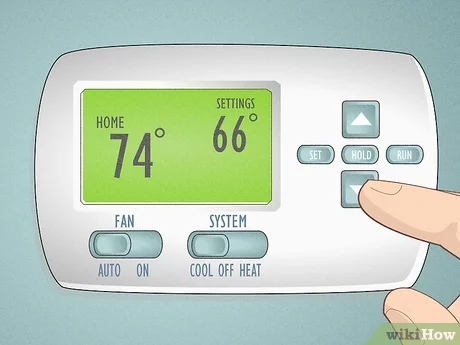The Ideal Thermostat Temperature in Winter
During the winter months, maintaining a comfortable temperature at home becomes a priority. The thermostat plays a crucial role in this process, as it controls the operation of the heating system and regulates the room temperature. In this article, we will explore the ideal temperature to set on the thermostat during the winter to achieve a balance between comfort and energy efficiency.
The Importance of Thermostat Temperature in Winter
The thermostat temperature in winter is essential for several reasons:
- Comfort and Wellbeing : Maintaining an adequate temperature in the home during the cold months is essential for the comfort and wellbeing of the occupants. A temperature that is too low can cause discomfort and health problems, while a temperature that is too high can result in a stifling environment.
- Energy Efficiency : Correctly setting your thermostat can help reduce energy consumption and heating costs, resulting in significant savings on your utility bill.
- Home Protection : Maintaining proper temperatures also helps prevent problems such as frozen pipes, moisture buildup, and deterioration of building materials.
Factors that Influence the Ideal Thermostat Temperature
Several factors must be considered when determining the ideal thermostat temperature in winter:
- Climate and Geographic Location : Regional weather conditions such as outside temperature, humidity, and wind patterns can affect the optimal thermostat temperature.
- Home Size and Design : The size, layout, and insulation of your home all influence the amount of heat needed to maintain a comfortable temperature.
- Activity and Occupancy : The activity level of the occupants and the number of people in the home can affect the preferred temperature.
- Personal Preferences : Individual preferences and tolerance for cold or heat vary from person to person and should be taken into account.
Thermostat Temperature Recommendations in Winter
Although there is no universal temperature that fits all situations, some general guidelines can be offered:
- When the Home is Occupied : The recommended temperature for when the home is occupied is between 18°C (64°F) and 21°C (70°F). This range allows for a balance between comfort and energy efficiency.
- When the Home is Unoccupied : When the home is unoccupied, it is recommended to lower the temperature to between 15°C (59°F) and 18°C (64°F). This reduction helps save energy without compromising comfort too much upon returning.
- During the Night : For sleeping hours, a temperature between 16°C (61°F) and 18°C (64°F) is suggested. This lower setting can help improve sleep quality and reduce energy consumption.
It is important to note that these recommendations are general and may vary depending on individual preferences and specific household characteristics. Users are advised to adjust the thermostat temperature according to their comfort and needs.
Tips for Saving Energy with the Thermostat in Winter
In addition to setting the right temperature, there are other strategies that can help save energy and reduce heating costs during the winter:
- Schedule Your Thermostat : Use your thermostat’s scheduling feature to automatically adjust the temperature based on your home’s occupancy and activity schedules.
- Keep Your Thermostat Properly Calibrated : Make sure your thermostat is properly calibrated and provides accurate room temperature readings.
- Take advantage of sunlight : Open curtains and blinds during the day to take advantage of the sun’s natural heat, and close them at night to retain heat.
- Improve Insulation : Investing in good home insulation, such as walls, ceilings and windows, can help keep heat in and reduce energy loss.
- Perform Heating System Maintenance : Keeping your heating system in good condition through regular maintenance service can improve its efficiency and extend its lifespan.
Conclusion
Setting the right temperature on the thermostat during the winter is critical to achieving a balance between comfort and energy efficiency. By taking into account factors such as climate, home design, and personal preferences, general guidelines can be established to help users find the optimal setting for their home. Additionally, implementing complementary strategies such as thermostat programming and heating system maintenance can contribute to significant savings on heating costs.
Frequent questions
- What is the ideal thermostat temperature in winter when the home is occupied?
- The recommended temperature when the home is occupied is between 18°C (64°F) and 21°C (70°F).
- What temperature should be set on the thermostat when the home is unoccupied?
- When the home is unoccupied, it is recommended to lower the temperature to between 15°C (59°F) and 18°C (64°F).
- What is the ideal thermostat temperature at night?
- For sleeping hours, a temperature between 16°C (61°F) and 18°C (64°F) is suggested.
- How can I save energy with the thermostat in winter?
- Some energy-saving strategies include programming your thermostat, keeping it well calibrated, taking advantage of sunlight, improving insulation, and maintaining your heating system.
- Are there factors that influence the ideal thermostat temperature?
- Yes, factors such as climate, home size and layout, activity and occupancy, and personal preferences can affect the optimal thermostat temperature.
Relevant information
| Issue | Link |
|---|---|
| Saving Energy at Home | https://www.energy.gov/energysaver/home-heating-systems/thermostats |






More Stories
What goes Good with Pizza
How many Electrons Does Silicon Have
How Long Does It Take to Get a Law Degree